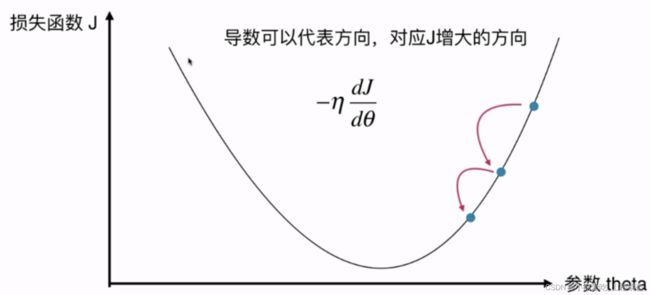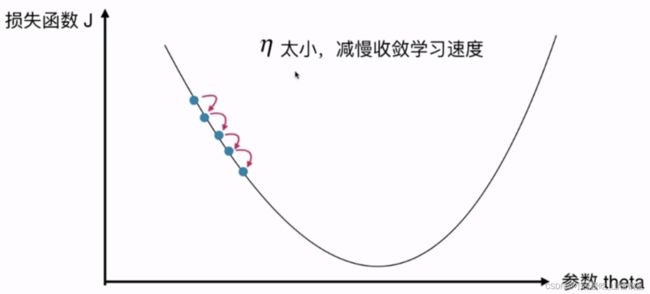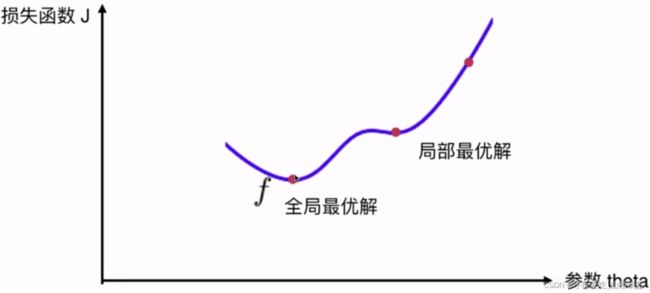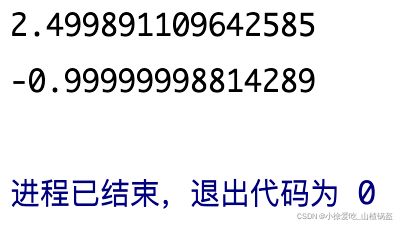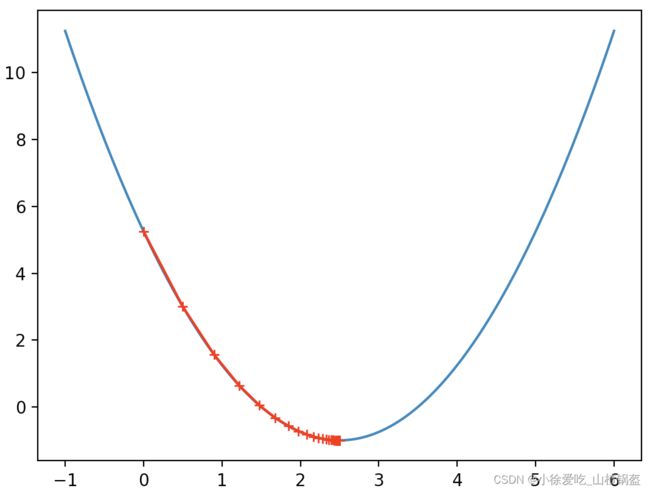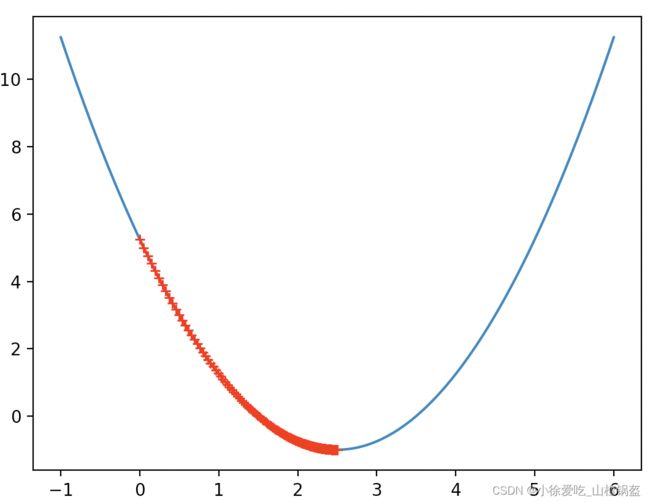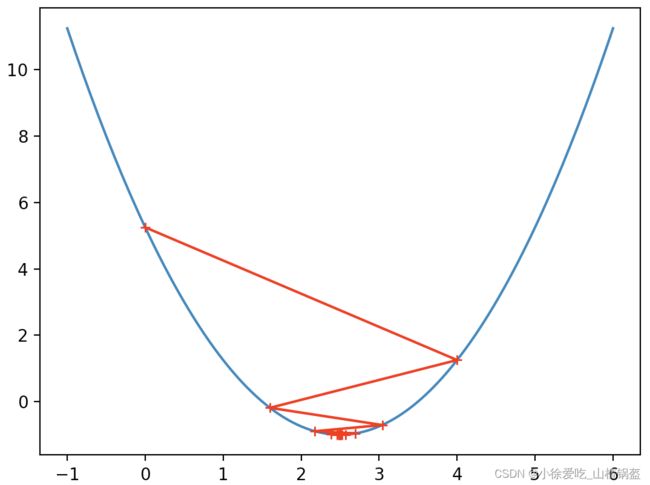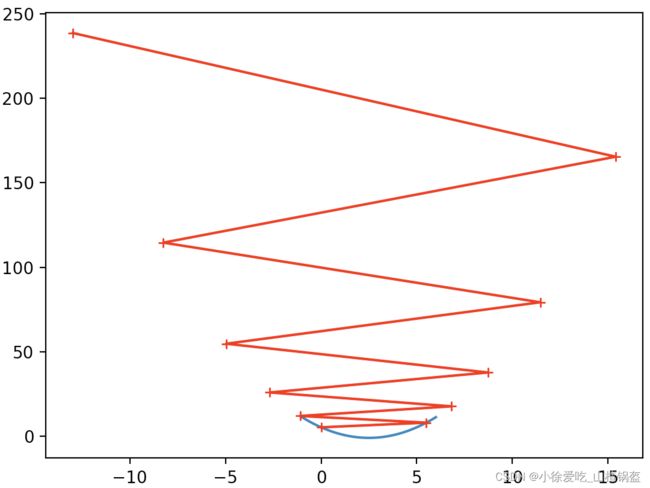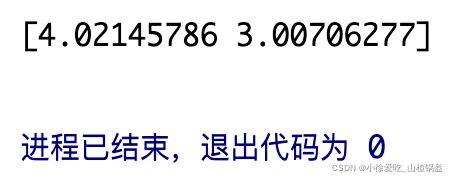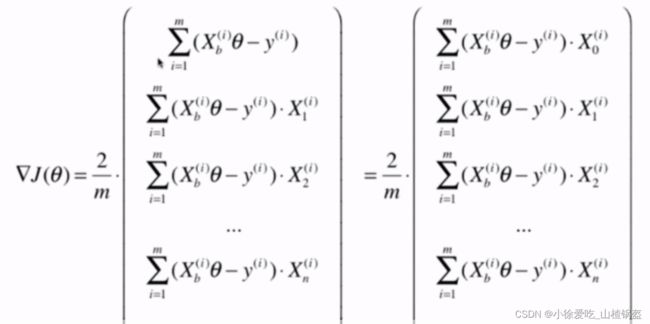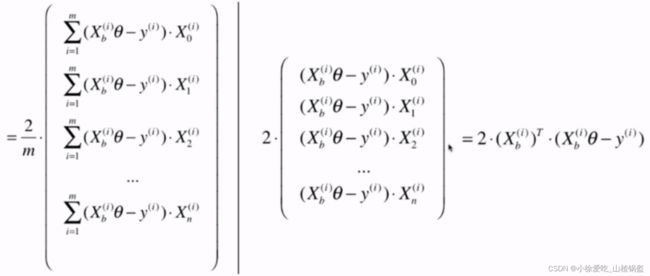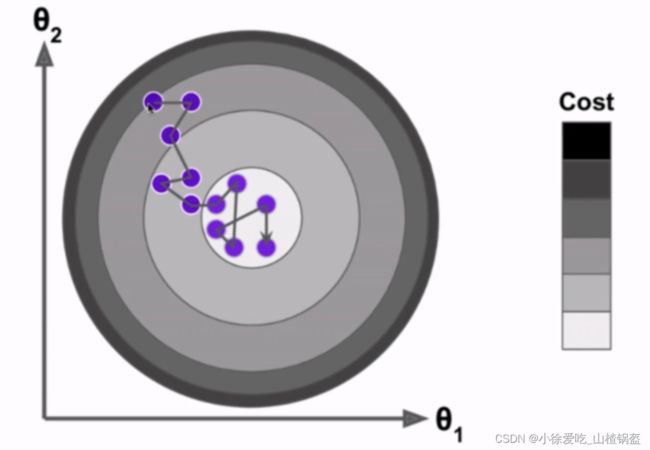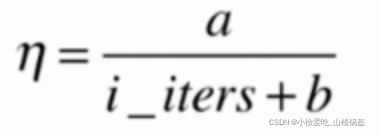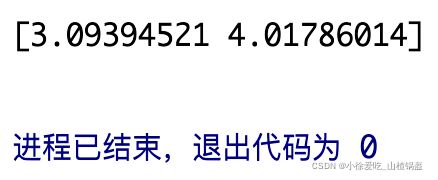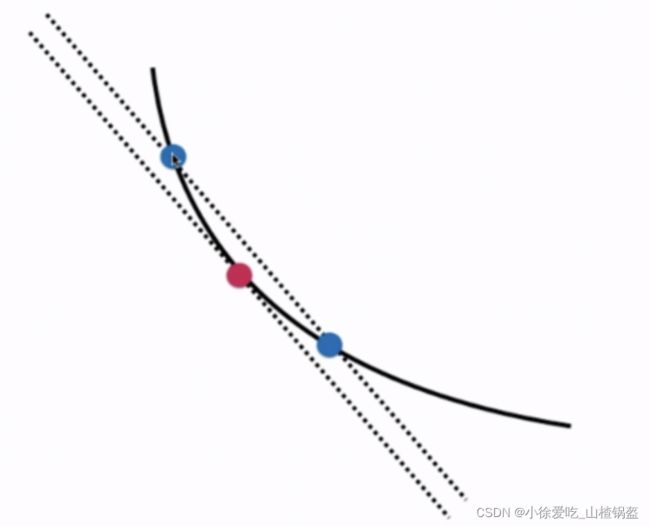03机器学习--梯度下降及python实现
目录
①概述
②梯度下降法简单模拟
③多元线性回归中使用梯度下降
④优化(梯度下降法的向量化)
⑤数据的归一化
⑥随机梯度下降法
⑦scikit-learn中的随机梯度下降
⑧关于梯度的调试
⑨总结
①概述
- 不是一个机器学习算法
- 是一种基于搜索的最优化方法
- 作用:最小化一个损失函数
- 梯度上升法:最大化一个效用函数
思路:由上图可知,在损失函数上的某一个点,希望经过变化到达损失函数最小值点,所以对损失函数求导,导数代表函数增大的方向,为了让函数变小,所以在导数前面增加负号,又因为需要逐步靠近最低点,所以在导数前面增加了步长![]() ,逐步靠近导数为0的位置。下降的速度就是由
,逐步靠近导数为0的位置。下降的速度就是由![]() 决定
决定
 称为学习率(learning rate)
称为学习率(learning rate) 的取值影响获得最优解的速度
的取值影响获得最优解的速度 的取值不合适,甚至得不到最优解
的取值不合适,甚至得不到最优解 是梯度下降法的一个超参数
是梯度下降法的一个超参数
注意:并不是所有函数都有唯一极值点
解决方案:
- 多次运行,随机化初始点
- 梯度下降法的初始点也是一个超参数
②梯度下降法简单模拟
1)假设一个损失函数并绘制
import numpy as np
import matplotlib.pyplot as plt
# 随便画一个损失曲线
plot_x = np.linspace(-1, 6, 141)
plot_y = (plot_x - 2.5) ** 2 - 1
plt.plot(plot_x, plot_y)
plt.show()输出结果:
2)实现梯度下降
import numpy as np
import matplotlib.pyplot as plt
# 随便画一个损失曲线
plot_x = np.linspace(-1, 6, 141)
plot_y = (plot_x - 2.5) ** 2 - 1
# plt.plot(plot_x, plot_y)
# plt.show()
def J(theta): # 损失函数
return (theta - 2.5) ** 2 - 1
def dJ(theta): # 当前点的导数
return 2 * (theta - 2.5)
# 梯度下降过程
theta = 0.0 # 一般以0为初始点
while True:
gradient = dJ(theta) # 求当前点对应的梯度(导数)
last_theta = theta # 学习前的theta
eta = 0.1
theta = theta - eta * gradient # 参数值向导数负方向移动,eta为学习率,假设学习率为0.1
epsilon = 1e-8 # 精度
# 各种情况会导致最终导数不是刚好为0,如果每次学习过后,损失函数的减小值达到某一精度,我们就认为他学习结束(基本上到达最小值)
if (abs(J(theta) - J(last_theta)) < epsilon):
break
print(theta) # 损失函数最小值横坐标
print(J(theta)) # 损失函数最小值输出结果:
观察一下学习的过程:
import numpy as np
import matplotlib.pyplot as plt
# 随便画一个损失曲线
plot_x = np.linspace(-1, 6, 141)
plot_y = (plot_x - 2.5) ** 2 - 1
# plt.plot(plot_x, plot_y)
# plt.show()
def J(theta): # 损失函数
return (theta - 2.5) ** 2 - 1
def dJ(theta): # 当前点的导数
return 2 * (theta - 2.5)
# 梯度下降过程
theta = 0.0 # 一般以0为初始点
theta_history = [theta]
while True:
gradient = dJ(theta) # 求当前点对应的梯度(导数)
last_theta = theta # 学习前的theta
eta = 0.1
theta = theta - eta * gradient # 参数值向导数负方向移动,eta为学习率,假设学习率为0.1
theta_history.append(theta)
epsilon = 1e-8 # 精度
# 各种情况会导致最终导数不是刚好为0,如果每次学习过后,损失函数的减小值达到某一精度,我们就认为他学习结束(基本上到达最小值)
if (abs(J(theta) - J(last_theta)) < epsilon):
break
plt.plot(plot_x, J(plot_x))
plt.plot(np.array(theta_history), J(np.array(theta_history)), color="r", marker='+')
plt.show()输出结果:
可以观察到刚开始移动的幅度比较大,是因为刚开始梯度比较陡,越到后面梯度越平缓,移动的幅度就越小。
3)改变一下学习率
import numpy as np
import matplotlib.pyplot as plt
# 随便画一个损失曲线
plot_x = np.linspace(-1, 6, 141)
plot_y = (plot_x - 2.5) ** 2 - 1
def J(theta):
return (theta-2.5)**2 - 1.
def dJ(theta):
return 2*(theta-2.5)
# 把上面的梯度下降函数封装起起来
def gradient_descent(initial_theta, eta, epsilon=1e-8):
theta = initial_theta
theta_history.append(initial_theta)
while True:
gradient = dJ(theta)
last_theta = theta
theta = theta - eta * gradient
theta_history.append(theta)
if (abs(J(theta) - J(last_theta)) < epsilon):
break
# 绘制学痕迹
def plot_theta_history():
plt.plot(plot_x, J(plot_x))
plt.plot(np.array(theta_history), J(np.array(theta_history)), color="r", marker='+')
plt.show()
eta = 0.01
theta_history = []
gradient_descent(0, eta)
plot_theta_history()输出结果:
很明显学习的步数更多了,因为学习率(0.01)小了很多。
再改一下:学习率(0.8)后
输出结果:
又改一下:学习率(1.1)后
输出结果:
会发现报错,因为学习率太大,导致每次学习之后,损失函数没有变小反而变大,一次次的变大,最后结果会很大。
限制循环次数(10次)观察一下:
import numpy as np
import matplotlib.pyplot as plt
# 随便画一个损失曲线
plot_x = np.linspace(-1, 6, 141)
plot_y = (plot_x - 2.5) ** 2 - 1
def J(theta):
return (theta-2.5)**2 - 1.
def dJ(theta):
return 2*(theta-2.5)
# 把上面的梯度下降函数封装起起来
def gradient_descent(initial_theta, eta, n_iters=1e4, epsilon=1e-8):
theta = initial_theta
i_iter = 0
theta_history.append(initial_theta)
while i_iter < n_iters:
gradient = dJ(theta)
last_theta = theta
theta = theta - eta * gradient
theta_history.append(theta)
if (abs(J(theta) - J(last_theta)) < epsilon):
break
i_iter += 1
return
# 绘制学痕迹
def plot_theta_history():
plt.plot(plot_x, J(plot_x))
plt.plot(np.array(theta_history), J(np.array(theta_history)), color="r", marker='+')
plt.show()
eta = 1.1
theta_history = []
gradient_descent(0, eta, n_iters=10)
plot_theta_history()输出结果:
③多元线性回归中使用梯度下降
# coding=utf-8
import numpy as np
import matplotlib.pyplot as plt
# 编造一组数据
np.random.seed(666) # 随机种子
x = 2 * np.random.random(size=100) # 100个样本每个样本1个特征
y = x * 3 + 4 + np.random.normal(size=100)
X = x.reshape(-1, 1)
# 绘制样本
# plt.scatter(x, y)
# plt.show()
# 使用梯度下降法训练
def J(theta, X_b, y): # 计算损失函数
try:
return np.sum((y - X_b.dot(theta)) ** 2) / len(X_b)
except:
return float('inf')
# 对损失函数求导
def dJ(theta, X_b, y): # 导数 x_b是增加了第一列1的矩阵,上一节中有说明
res = np.empty(len(theta)) # 开一个空间存最终结果
res[0] = np.sum(X_b.dot(theta) - y) # 第一项导数
for i in range(1, len(theta)): # 剩下项导数
res[i] = (X_b.dot(theta) - y).dot(X_b[:, i])
return res * 2 / len(X_b)
# 梯度下降的过程,上面写过的
def gradient_descent(X_b, y, initial_theta, eta, n_iters=1e4, epsilon=1e-8):
theta = initial_theta
cur_iter = 0
while cur_iter < n_iters:
gradient = dJ(theta, X_b, y)
last_theta = theta
theta = theta - eta * gradient
if abs(J(theta, X_b, y) - J(last_theta, X_b, y)) < epsilon:
break
cur_iter += 1
return theta
# 调用
X_b = np.hstack([np.ones((len(x), 1)), x.reshape(-1, 1)]) # 增加第一列
initial_theta = np.zeros(X_b.shape[1])
eta = 0.01
theta = gradient_descent(X_b, y, initial_theta, eta)
print(theta) # 本例输出theta0和theta1分别对应截距和斜率输出结果:
④优化(梯度下降法的向量化)
在上一部分梯度中每一项我们是用循环一个一个算出来的,这里对第0项进行变形:
拆成两个矩阵点乘的形式:(一个行向量)
严谨起见,再把它转置为流向量:(因为原来就是一个列向量)
在原来的导数函数基础上做修改即可
# 把原来的dJ函数优化一下
def dJ(theta, X_b, y):
return X_b.T.dot(X_b.dot(theta) - y) * 2 / len(X_b)⑤数据的归一化
解决数据维度不同的情况,因为数据维度不同很有可能会增加很多搜索的时间,第一章有提到过。
01机器学习--kNN分类学习笔记及python实现_小徐爱吃_山楂锅盔的博客-CSDN博客
⑥随机梯度下降法
缺陷:上面提到的梯度下降法,每一次计算过程,都要对样本中对每一个x进行求导,属于批量梯度下降法。
优化:每次只对一个x进行求导,每次固定一个i
随机梯度下降法搜索过程如下(不能保证每次的方向一样,有一定的不可预知性):
但是实验结果告诉我们他也是可行的,m非常大的话,宁愿损失一定的精度来换取时间,这时候随机梯度下降法的意义就体现出来了。
学习率的取值变得很重要,实践中希望学习率是随着循环次数增加逐渐递减的(个人理解为越靠近最低点越谨慎),如下:
a,b就是随机梯度下降法中的超参数
import numpy as np
import matplotlib.pyplot as plt
m = 100000
x = np.random.normal(size=m)
X = x.reshape(-1, 1)
y = 4. * x + 3. + np.random.normal(0, 3, size=m)
def dJ_sgd(theta, X_b_i, y_i): # 传的是X_b的某一行
return 2 * X_b_i.T.dot(X_b_i.dot(theta) - y_i)
def sgd(X_b, y, initial_theta, n_iters): # 不用传学习率,这里不详细说明t的取值
t0, t1 = 5, 50
def learning_rate(t): # 变化的学习率
return t0 / (t + t1)
theta = initial_theta
for cur_iter in range(n_iters):
rand_i = np.random.randint(len(X_b)) # 随机一个样本
gradient = dJ_sgd(theta, X_b[rand_i], y[rand_i])
theta = theta - learning_rate(cur_iter) * gradient
return theta
X_b = np.hstack([np.ones((len(X), 1)), X])
initial_theta = np.zeros(X_b.shape[1])
theta = sgd(X_b, y, initial_theta, n_iters=m // 3) # 这里人为的让循环次数为样本数的1/3
print(theta)
结果输出:
在这里使用的随机梯度比上面的批量梯度要节省许多时间,发现就算只循环了样本数的1/3页能够拟合到不错的效果,但是实际情况中不能人为的限制循环次数为1/3,这里只是想展示随机梯度的效果。
⑦scikit-learn中的随机梯度下降
只能解决线性模型
import numpy as np
from sklearn import datasets
# 前一章用过的房价数据集
boston = datasets.load_boston()
X = boston.data
y = boston.target
X = X[y < 50.0]
y = y[y < 50.0]
# 划分数据集
from sklearn.model_selection import train_test_split
X_train, X_test, y_train, y_test = train_test_split(X, y, test_size=0.2, random_state=666)
# 数据归一化
from sklearn.preprocessing import StandardScaler
standardScaler = StandardScaler()
standardScaler.fit(X_train)
X_train_standard = standardScaler.transform(X_train)
X_test_standard = standardScaler.transform(X_test)
# 梯度下降实现
from sklearn.linear_model import SGDRegressor
sgd_reg = SGDRegressor(n_iter_no_change=50) # 限定浏览次数,默认值5
sgd_reg.fit(X_train_standard, y_train)
print(sgd_reg.score(X_test_standard, y_test))
结果输出:
⑧关于梯度的调试
怎样才能发现梯度求错了?(导数可能被自己推错了)
蓝点间距离越近,他们之间连线的斜率与红点处切线的斜率约相近
对于高维度
import numpy as np
import matplotlib.pyplot as plt
# 编一组数据
np.random.seed(666)
X = np.random.random(size=(1000, 10))
true_theta = np.arange(1, 12, dtype=float)
X_b = np.hstack([np.ones((len(X), 1)), X])
y = X_b.dot(true_theta) + np.random.normal(size=1000)
# 损失函数
def J(theta, X_b, y):
try:
return np.sum((y - X_b.dot(theta))**2) / len(X_b)
except:
return float('inf')
# 用数学推导的方式求导数
def dJ_math(theta, X_b, y):
return X_b.T.dot(X_b.dot(theta) - y) * 2. / len(y)
# 用逼近的思想进行计算导数
def dJ_debug(theta, X_b, y, epsilon=0.01):
res = np.empty(len(theta))
for i in range(len(theta)): # 每一次求一个维度对应的值
theta_1 = theta.copy() # 原始的theta
theta_1[i] += epsilon # 第i个维度加一个邻域
theta_2 = theta.copy()
theta_2[i] -= epsilon # 第i个维度减一个邻域
res[i] = (J(theta_1, X_b, y) - J(theta_2, X_b, y)) / (2 * epsilon) # 两点连线的斜率
return res
# 批量梯度下降
def gradient_descent(dJ, X_b, y, initial_theta, eta, n_iters=1e4, epsilon=1e-8):
theta = initial_theta
cur_iter = 0
while cur_iter < n_iters:
gradient = dJ(theta, X_b, y)
last_theta = theta
theta = theta - eta * gradient
if (abs(J(theta, X_b, y) - J(last_theta, X_b, y)) < epsilon):
break
cur_iter += 1
return theta
X_b = np.hstack([np.ones((len(X), 1)), X])
initial_theta = np.zeros(X_b.shape[1])
eta = 0.01
theta = gradient_descent(dJ_debug, X_b, y, initial_theta, eta)
print(theta)
theta = gradient_descent(dJ_math, X_b, y, initial_theta, eta)
print(theta)结果输出:
逼近的思想其实运行速度会慢很多,但是也是可行的,使用这个逼近的思想,主要是可以用来验证,自己开始推导的那个数学解是否正确。
⑨总结
- 批量梯度下降法:求解速度较慢,但是稳定
- 随机梯度下降法:计算快,但是不稳定,每一次的方向不确定
- 综合二者优缺点:小批量梯度下降法(每次看k个样本),这里不具体实现,只是在随机梯度的每次一个x改成k个x,多了一个超参数k。
一个重点概念---随机:跳出局部最优解、更快运行速度,比如随机森林、随机搜索,后续还有介绍
梯度上升法:求某个目标函数的最大值,把学习率前面的负号去掉就可以
